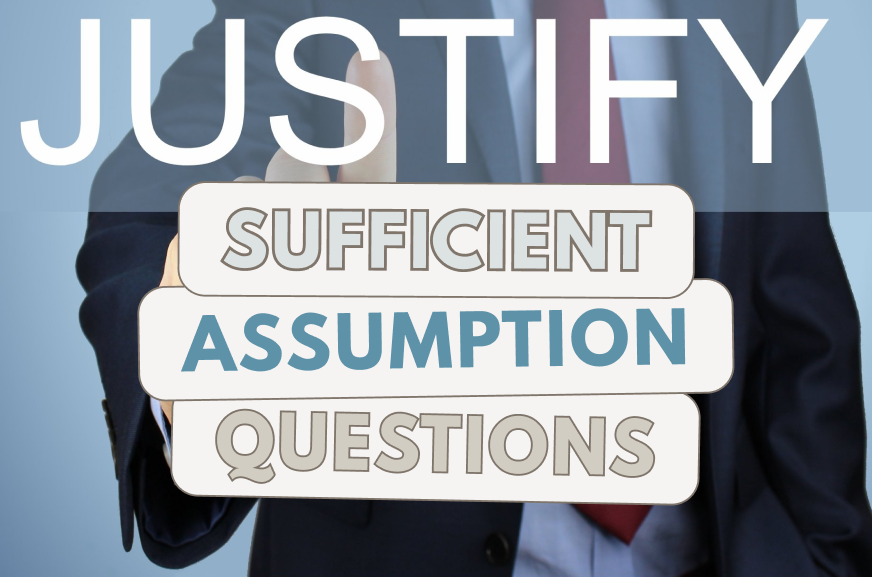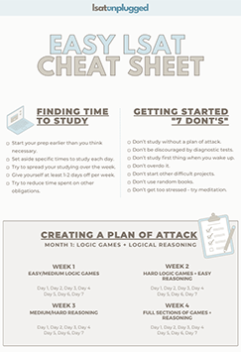Many of you dislike formal logic Logical Reasoning questions, particularly Sufficient Assumption (aka Justify) questions. In this blog post, I’ll demonstrating my technique on a few of these questions.
Unfortunately, the folks at LSAC are very strict about their intellectual property and wouldn’t allow me to post their LSAT questions online, so I’m only posting my explanations for the questions.
Not to worry, though.
In this blog post, I reference specific PrepTests, sections, and question numbers so you can follow along, as well as their page numbers in the books containing 10 PrepTests each.
First, a quick drill:
Suppose you had an argument containing:
Evidence: A —> B
Conclusion: C —> B
One sufficient assumption that closes the gap would be: C —> A
Why?
Because if all C’s are A’s, and all A’s are B’s, then all C’s must be B’s (C —> A —> B).
Another sufficient assumption would be NOT B —> NOT C
If the contrapositive of the conclusion is true, then the conclusion itself must be true as well.
***
Side note:
Some students ask, why doesn’t A —> C work?
Well, suppose we knew A —> C were true. What would our premises (pieces of evidence) be?
We’d now have:
A —> B (from original evidence)
A —> C (from new information – students’ proposed answer)
This doesn’t provide us with a conditional relationship between B and C. (Rather, it would simply allow us to infer that “Some Bs are Cs” and vice-versa, of course.)
It’s like saying:
Apples (A) —> Fruit (B) = If it’s an apple, then it’s a fruit.
Apples (A) —> Food (C) = If it’s an apple, then it’s food.
Does this tell us that all food (C) is fruit (B)?
Of course not.
***
Because there are multiple ways to justify the conclusion, we can say any particular sufficient assumption does not necessarily need to be true to justify the conclusion. However, a sufficient assumption will be enough to justify the conclusion. It might involve the evidence, but it also might not. As you complete more sufficient assumption questions, you’ll get a sense of which type of sufficient assumption they’re looking for.
***
PrepTest 38 (October 2002 LSAT), Section 4, Question 16 – page 346 in Next 10
(the question discusses: people, distrust, confident, abilities, challenge)
Question Stem: “The conclusion above follows logically if which one of the following is assumed?”
Evidence group: People who do not believe that others distrust them
Conclusion group: People who tend to trust others
After identifying each piece of the stimulus, we can arrange them like this:
Evidence: Not Believe Others Distrust —> Confident —> Difficult Task as Challenge
Conclusion: Tend to Trust Others —> Confident —> Difficult Task as Challenge
We could diagram this as:
Evidence: NOT BOD —> C —> DTC
Conclusion: TTO —> DTC
The necessary condition (regarding/thinking about each difficult task as a challenge rather than as a threat) is the same for both. Why? Because the final clause (“since this is precisely how…”) supports the part of the conclusion that states “think of a difficult task as a challenge…” Since we know that “Difficult Task as Challenge” is a necessary result of “Confidence,” we can put DTC after C in the evidence.
The cleanest way to close the gap is to say everyone in the conclusion’s group of people (“people who tend to trust others” = “TTO” ) falls within the evidence’s group of people (“people who did not believe that others distrust them” = “NOT BOD”).
Choice C says this word for word.
The key is in noticing the evidence group and conclusion group are really discussing two different groups of people, and we don’t know anything about how they relate to each other.
As always, try not to get overly involved with (or scared by) the topic of the argument. Instead, focus on its structure. This is especially true for the following question I explain.
***
PrepTest 35 (October 2001 LSAT), Section 1, Question 22 – page 226 of Next 10
(the question discusses: chordates, tracheophytes, Pteropsida, Hominidae)
Question Stem: “The conclusion drawn above follows logically if which one of the following is assumed?”
Explanation:
Evidence #1: No Cs are Ts = C —> NOT T
Contrapositive: T —> NOT C
Evidence #2: All members of P are T = P —> T
If we connect these, we get:
Evidence #1’s contrapositive and Evidence #2, combined: P —> T —> NOT C
Contrapositive of that combination: C —> NOT T —> NOT P = C —> NOT P
Conclusion:
P —> NOT H
Contrapositive of conclusion: H —> NOT P
Evidence: C —> NOT T —> NOT P
Conclusion: H —> NOT P
The goal of all this is to make the necessary conditions the same.
The drill at the start of this blog post already had “B” as the necessary condition of both evidence and conclusion, so there was no need to manipulate anything by taking the contrapositive.
However, this question is more difficult than the drill. We need to do some extra work by taking the contrapositive of what they gave us to get to the point where the evidence and conclusion both have “NOT P”
Now, to close the gap, I want to take the conclusion group’s sufficient condition (H) and say it always falls within the evidence group’s sufficient condition (C).
If all Hs are Cs, and we already know all Cs are NOT Ps, then all Hs must be NOT Ps as well, because:
H —> C —> NOT P
Very nice, clean, mechanical, and formulaic. No need to engage in any real thinking about the topic itself – just the pieces.
***
PrepTest 24 (December 1997 LSAT), Section 3, Question 19 – page 207 of 10 More
(the question discusses: students, school, home, lunch, part-time jobs, walk)
Question stem: “The conclusion of the argument follows logically if which one of the following is assumed?”
Explanation:
Evidence: walk to school —> go home for lunch.
Conclusion: Some with part-time jobs don’t walk to school.
E: WS —> GHL
C: Some PTJ —> NOT WS
I want to make evidence and conclusion have the same necessary conditions, so I’ll take the contrapositive of the evidence:
Evidence: NOT GHL —> NOT WS
Conclusion: Some PTJ —> NOT WS
To close the gap, I want to say some students with PTJ don’t go home for lunch.
I look for this, and I don’t see it.
No need to go WTF, though, because we only need some overlap between the groups.
(Example: If some candy bars are delicious, then at least some delicious things are candy bars. The word “some” always allows for reversibility because the word “some” is vague.)
D indicates overlap between the groups, so it’s our answer.
***
Note: this is a different “format” (logical structure) from the above questions.
PrepTest 9 (October 1993 LSAT), Section 2, Question 23 – page 64 in 10 Actual
(the question discusses: poor farmer, rich farmers, honest, dishonest)
Question stem: “The farmer’s conclusion is properly drawn if the argument assumes that”
Explanation:
The sentence of the stimulus stating you’re either rich or poor and either honest or dishonest is crucial.
This tells us the negation of rich is poor (and vice-versa) and the negation of honest is dishonest (and vice-versa).
Evidence: “All poor farmers are honest.” = If Poor —> Honest
Conclusion: “All rich farmers are dishonest.” = If Rich —> Dishonest
Evidence: P —> H
Conclusion: R —> DH
Contrapositive of Conclusion: NOT Dishonest —> NOT Rich = Honest —> Poor
Which is exactly what choice A says.
If the contrapositive of the conclusion is true (Choice A), then the conclusion itself is true also.
(As a side note, if choice A is not true, the argument is simply exhibiting a mistaken reversal, which is invalid.)

